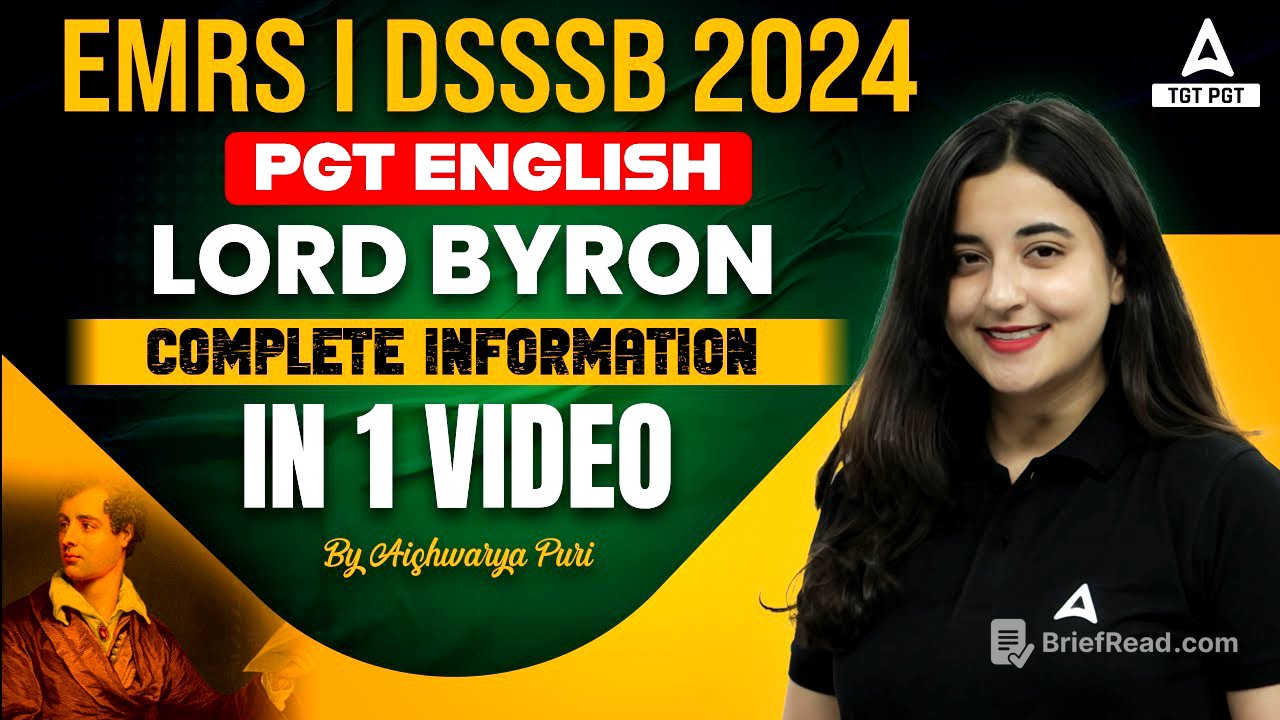TLDR;
This video provides an overview of Lord Byron's life and major works, focusing on his unique position within the Romantic poets. It explores his non-conformist approach to poetry, his travels, and his engagement with political issues. The lecture highlights key works like "Childe Harold's Pilgrimage" and "Don Juan," discussing their themes, styles, and significance, as well as the concept of the Byronic hero.
- Lord Byron's unique position within the Romantic poets.
- Key works: "Childe Harold's Pilgrimage" and "Don Juan".
- Concept of the Byronic hero.
Introduction to Lord Byron [0:00]
The lecture introduces Lord Byron as a second-generation Romantic poet who differed from his contemporaries by not focusing on nature or considering himself a literary genius. Byron was a non-salient writer who loved traveling and incorporated his experiences into his poetry. Romanticism is defined as freedom, liberty, and the enjoyment of personal freedom, which Byron embodied.
Life and Personality of Lord Byron [2:04]
Lord Byron, whose full name was George Gordon Byron, had a club foot, which caused him to walk with a limp. Despite this, he was a popular and fashionable figure, with many people copying his style. He traveled extensively, visiting places like Greece, Spain, Portugal, Malta, and Albania, gathering social and political issues that he addressed in his poetry. After his work "Childe Harold's Pilgrimage," he famously said, "I woke up and found myself famous." In 1823, he was elected to the Greek Committee of Liberty against the Turks, reflecting his support for Greek independence.
Chronology of Byron's Works [5:07]
The lecture outlines the chronology of Lord Byron's major works. "Hours of Idleness" was published in 1807 and received negative reviews, leading to "English Bards and Scotch Reviewers" in 1809, a satirical response initially intended to critique the contemporary English poetic scene. The first two cantos of "Childe Harold's Pilgrimage" were published in 1812, followed by the third and fourth cantos in 1818. Other notable works include "The Bride of Abydos" (1813), "Hebrew Melodies" (1815), "The Siege of Corinth" (1816), "Manfred" (1817), "Beppo" (1818), and "Don Juan" (1819-1824), which remained incomplete. Byron was inspired by Greek and Italian styles, using octo-syllabic verses and tetrameter in his poetry.
Analysis of Key Poems [8:30]
The lecture highlights "Childe Harold's Pilgrimage" and "Don Juan" as Byron's most significant works. "The Vision of Judgement" (1821) is mentioned as a satirical poem. The poem "She Walks in Beauty Like the Night" (1814) is analyzed for its use of simile in the opening lines.
The Byronic Hero [10:02]
The concept of the Byronic hero is discussed, describing a character similar to Lord Byron himself: a libertine who disregards social conventions and acts according to his own will. This character, often of noble birth, is discontent with his social class, licentious, well-traveled, and may exhibit arrogance but is not inherently bad. The Byronic hero is charming, confident, and somewhat narcissistic, a character popularized through "Childe Harold's Pilgrimage."
Childe Harold's Pilgrimage [12:06]
"Childe Harold's Pilgrimage" is a semi-autobiographical work written in four cantos, with the first two published in 1812 and the last two in 1818. The poem follows Child Harold, a young nobleman, who becomes disillusioned with the world's pleasures and embarks on a journey for self-discovery. The character is a typical Byronic hero: dark, brooding, mysterious, and a social outcast. Byron incorporates his travels to Greece, Portugal, Albania, and Malta into the poem, using Spenserian stanzas. The poem also reflects Byron's observations of socio-political issues, such as Greece's fight for independence from the Ottoman Empire.
Don Juan [16:04]
Lord Byron's "Don Juan" borrows from the medieval Spanish libertine character but subverts the original traits. Instead of a womanizer, Byron's Don Juan is innocent and easily influenced by women. The poem, written in Ottava Rima (eight-line stanzas with a rhyme scheme of ABABABCC), was left incomplete after 16 cantos. Byron dedicates the poem sarcastically to Robert Southey and William Wordsworth, acknowledging their superior poetic style. The poem begins with the famous lines, "I want a hero, an uncommon want," setting a satirical and paradoxical tone.
English Bards and Scotch Reviewers [19:34]
"English Bards and Scotch Reviewers" is a non-fictional work initially intended to critique the contemporary literary scene in England. After "Hours of Idleness" received negative reviews from the Edinburgh Review, Byron specifically targeted its editor and Scottish reviewers in this poem. Written anonymously in Heroic Couplets, the poem draws inspiration from Alexander Pope's satirical style. Byron expresses discontent with the intellectual circles of his time, criticizing the overvaluing of reason and the excess in contemporary writing. He advocates for quality over quantity and praises literary giants like Shakespeare, Milton, and Pope, while also commenting on contemporary writers like Wordsworth, Southey, and Coleridge.




![‘세계 최초 금지법’까지 만들었는데...왜 미국·유럽처럼 안 바뀌는 거죠? [뉴스 쉽게보기]](https://wm-img.halpindev.com/p-briefread_c-10_b-10/urlb/aHR0cHM6Ly9pbWduZXdzLnBzdGF0aWMubmV0L2ltYWdlLzAwOS8yMDI1LzA5LzIxLzAwMDU1NjIxMzJfMDAxXzIwMjUwOTIxMTM1NDA3MjMyLnBuZz90eXBlPXc4MDA=.jpg)




